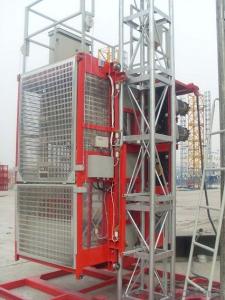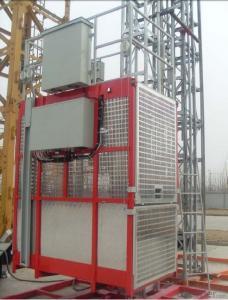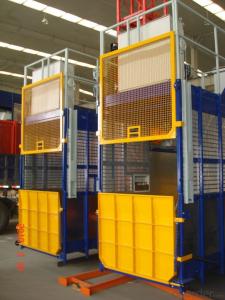construction hoist / builder's hoist/building hoist/SC120
- Loading Port:
- Tianjin
- Payment Terms:
- TT OR LC
- Min Order Qty:
- 1 unit
- Supply Capability:
- 100 unit/month
OKorder Service Pledge
Quality Product, Order Online Tracking, Timely Delivery
OKorder Financial Service
Credit Rating, Credit Services, Credit Purchasing
You Might Also Like
CMAX BUILDING HOIST SC120
DOUBLE CAGES
MAX LOADING CAPACITY= 1X1.2T
CAGE SIZE= 3X1.3X2.5 M
MOTOR POWER= 2X11KW
MAST SECTION SIZE= 650X650X1508 MM
MAST SECTION & ATTACHED FRAME
TYPE OF SAFETY DEVICE: SAJ30-1.2 ADOPT HOT GALVANIZING PROCESSING
WITH OVERLOAD LIMITER & ALARM SYSTEM
- Q: This question asks for the proper usage guidelines for a building hoist, a mechanical device used in construction to lift materials.
- <p>To use a building hoist correctly, follow these steps: Ensure the hoist is inspected and certified for safe operation. Check all safety devices, including limit switches and emergency stops, are functioning. Securely attach the load to the hoist's hook, ensuring it's balanced and within weight limits. Never exceed the hoist's capacity. Operate the hoist with caution, avoiding sudden starts or stops. Keep the hoist area clear of people and obstacles. Use a tag line to guide the load if necessary. Always lower the hoist when not in use and secure it against wind or other forces. Regular maintenance and inspections are crucial to prevent accidents.</p>
- Q: Is it possible to utilize building hoists in environments with high altitudes?
- <p>Yes, building hoists can be used in high-altitude environments, but their performance may be affected. At high altitudes, reduced air density can lead to decreased efficiency in hoist operations, particularly those powered by combustion engines. It's crucial to select hoists designed for high-altitude use, which may include features such as high-altitude ignition systems and special lubricants. Additionally, regular maintenance and adjustments to the hoist's operation parameters are necessary to ensure safety and optimal performance.</p>
- Q: Is it possible to use a building hoist for lifting light objects without any additional tools?
- <p>Yes, a building hoist can be used for lifting light objects without using any tools. Building hoists are designed to lift a variety of materials, including lighter items, within their weight capacity. However, it's crucial to ensure that the hoist is rated for the weight of the object and that safety protocols are followed to prevent accidents. Always consult the hoist's manual for specific guidelines on weight limits and safe operation procedures.</p>
- Q: Gear rack driven
- Driven by two or three worm gear reducers, the ladder cage is a load bearing unit, and gravity is carried by a rack. At rest, the force point is in the meshing of the gear and rack.
- Q: Is it possible to utilize a building hoist for the purpose of lifting heavy objects or construction materials?
- <p>Yes, a building hoist is specifically designed for lifting large objects and materials in construction settings. These hoists are engineered to handle heavy loads, making them ideal for transporting construction materials, equipment, and other heavy items vertically within a building. They are equipped with safety features and are regulated to ensure they can bear the weight and pressure of the materials being lifted, thus playing a crucial role in the construction process.</p>
- Q: Why do you ask the construction elevator to be a certain distance from the structure? Is very close to if not you can not bother to do delivery channel security protection or something, out of the elevator out directly, and attachment should be able to get more easily, to solve. Thank you very much!!
- Isn't there a car? Normally, the center line of the car should be in the same line as the support frame center. If the frame body (standard) get into the building, inevitably cause capsules center, usually the center of gravity and center is not a straight line on the standard section, capsules will force up and down roller, increase and the frame body wear, and certainly not safe.
- Q: Is it advisable to use personal lifting equipment without seeking professional advice first?
- <p>No, it is not advisable to use your own lifting equipment without consulting professionals first. Lifting operations can be hazardous and require specific knowledge and expertise to ensure safety. Professionals can assess the weight, stability, and appropriate lifting techniques required for your equipment. They can also provide guidance on safety regulations and the correct use of lifting gear, which is crucial to prevent accidents and injuries. Always consult with experts before undertaking any lifting tasks to ensure compliance with safety standards and to protect yourself and others.</p>
- Q: This question asks for the method to change the angle at which a building hoist operates.
- <p>Adjusting the angle of a building hoist involves several steps. First, ensure the hoist is turned off and disconnected from power sources. Next, locate the hoist's tilt adjustment mechanism, which is typically found at the base or on the mast. This mechanism often consists of a set of bolts or pins that can be loosened to allow the angle to be changed. Adjust the angle by moving the mast or base to the desired position, ensuring it is level and stable. Once the correct angle is achieved, tighten the bolts or pins to secure the hoist in place. Always follow the manufacturer's guidelines and safety precautions when making adjustments to prevent accidents.</p>
- Q: Is it permissible to use personal manual equipment for lifting objects instead of a construction hoist?
- <p>While it might be tempting to use your own manual equipment for lifting objects, it's generally not recommended for construction purposes. Building hoists are specifically designed for heavy lifting and are equipped with safety features that manual equipment may lack. Using manual equipment can pose significant safety risks, including the potential for accidents and injuries. Always follow safety regulations and use the appropriate equipment for the task at hand to ensure the safety of everyone on site.</p>
- Q: Is it possible for a building hoist to experience malfunctions that lead to damage?
- <p>Yes, a building hoist can malfunction and cause damage. Malfunctions can occur due to various reasons such as mechanical failure, operator error, or poor maintenance. These malfunctions can lead to accidents, including dropped loads, structural damage, or even injuries to workers. Regular inspections, proper maintenance, and adherence to safety protocols are crucial to minimize the risk of hoist malfunctions in construction settings.</p>
Send your message to us
construction hoist / builder's hoist/building hoist/SC120
- Loading Port:
- Tianjin
- Payment Terms:
- TT OR LC
- Min Order Qty:
- 1 unit
- Supply Capability:
- 100 unit/month
OKorder Service Pledge
Quality Product, Order Online Tracking, Timely Delivery
OKorder Financial Service
Credit Rating, Credit Services, Credit Purchasing
Similar products
Hot products
Hot Searches
Related keywords
























